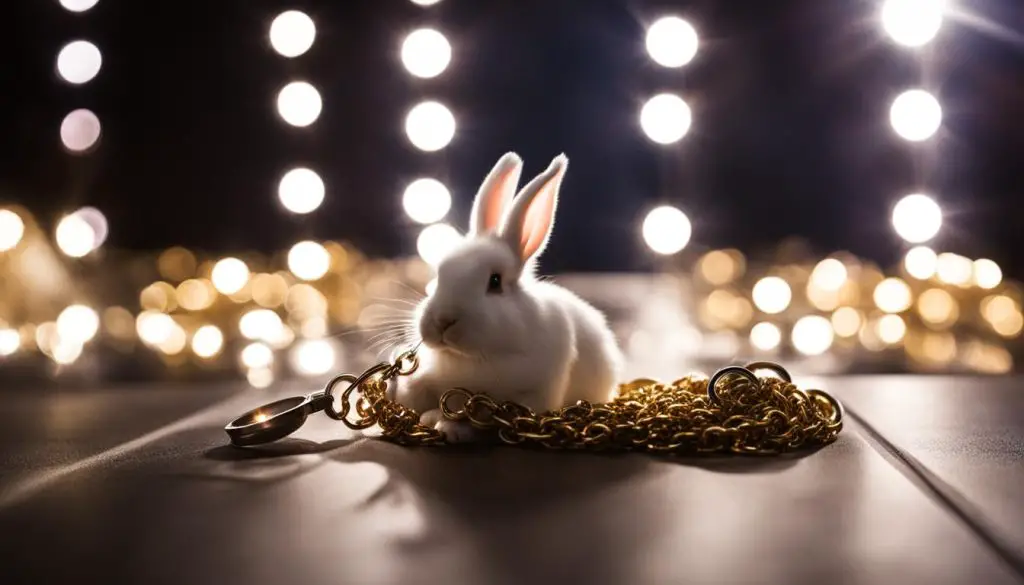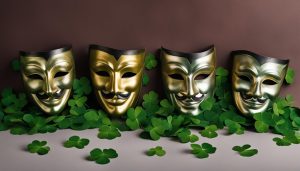The phrase “break a leg” is commonly used to wish performers good luck before a performance. This phrase is believed to have originated from the superstition that saying “good luck” actually brings bad luck in the theater.
The exact origin of the phrase is unclear, but it is thought to have evolved to counteract this superstition.
Some theories suggest that “break a leg” refers to bending the knee when taking a bow or stepping through the stage curtains (also known as “legs”) to receive applause at the end of a performance.
Others believe it may have started as an inside joke among theater actors. Regardless of its origin, the phrase is popular and has become a pre-performance ritual for many performers.
Contents [hide]
- 1 The Psychology Behind Superstitions Before Performances
- 2 The Effect of Good Luck Charms on Performance Confidence
- 3 Exploring the Origins and Theories of the “Break a Leg” Phrase
- 4 Debunking the Connection to Abraham Lincoln’s Assassination
- 5 Conclusion
- 6 FAQ
- 6.1 Is it bad to say good luck before a performance?
- 6.2 What is the psychology behind superstitions before performances?
- 6.3 Do good luck charms enhance performance confidence?
- 6.4 What is the origin of the phrase “break a leg”?
- 6.5 Is there a connection between “break a leg” and Abraham Lincoln’s assassination?
- 6.6 What is the significance of performance superstitions and saying “break a leg”?
- 7 Source Links
Key Takeaways:
- Saying “break a leg” is a common pre-performance ritual in the theater world.
- The phrase originated from the superstition that saying “good luck” brings bad luck.
- Performers engage in superstitious acts to build confidence and reduce performance anxiety.
- Good luck charms can serve as psychological anchors, enhancing performance confidence.
- The exact origin of the phrase “break a leg” remains unclear, with several theories proposed.
The Psychology Behind Superstitions Before Performances
Superstitions before performances, such as saying “break a leg,” are deeply rooted in the psychology of luck and performance.
These pre-performance rituals serve as a way for performers to mentally prepare themselves and build confidence, alleviating performance anxiety and enhancing their overall performance mindset.
Engaging in superstitious acts or using good luck charms creates a sense of control over the unpredictable nature of live performances. It allows performers to believe that they can influence the outcome of their performance through these symbolic actions.
Also read: Is It Bad Luck to Say Good Luck During a Spelling Bee?
This sense of control helps reduce anxiety and instills greater confidence, enabling performers to focus on their craft without being consumed by fear of failure.
“Superstitions are a way of giving oneself the illusion of control over unpredictable outcomes. It provides a psychological anchor and a sense of comfort in high-pressure situations,” explains Dr. Heather James, a performance psychologist.
These pre-performance rituals are deeply ingrained in theater culture and integral to performers’ routines. By following these superstitions, performers tap into a collective belief system passed down through generations of artists.
It fosters a sense of camaraderie and connection, creating a shared experience amongst performers and enhancing the overall performance atmosphere.
Performers’ Pre-Performance Rituals
Performers have diverse pre-performance rituals that they engage in to set the stage for success. Some common rituals include:
- She is wearing a specific clothing or accessory that holds personal significance.
- I am saying a particular phrase or mantra to instill confidence and focus.
- I am performing a specific warm-up routine to get into the right physical and mental state.
- She was carrying a lucky charm or talisman for reassurance and positive energy.
These rituals are unique to each performer and serve as a personal source of strength and motivation. They create a sense of familiarity and comfort, allowing performers to access their full potential and deliver their best performance on stage.
The Effect of Good Luck Charms on Performance Confidence
Many performers have personal good luck rituals or carry lucky charms to enhance their confidence.
These rituals and charms psychologically affect performers, providing a sense of comfort and familiarity in a high-pressure environment.
The belief in these objects or rituals can act as a psychological anchor, reinforcing the performer’s confidence and potentially improving their performance.
When performers engage in their good luck rituals or carry their lucky charms, they create a sense of control over their performance outcome. This sense of control helps reduce performance anxiety and allows performers to focus on their craft without fear of failure.
It is a way for performers to mentally prepare themselves and build confidence before stepping onto the stage.
Also read: Is It OK to Say Good Luck Before an Audition?
Whether it’s wearing a specific item of clothing, reciting a mantra, or carrying a lucky talisman, these rituals and charms serve as sources of positive reinforcement and belief in one’s abilities.
They remind performers of their successes and instill confidence that they can replicate them in future performances.
By having a physical object or a pre-performance routine, performers create a sense of security and a positive mindset, leading to improved performance confidence.
Example of a Good Luck Ritual Table:
| Performer | Ritual | Effect on Performance Confidence |
|---|---|---|
| Actor Antonio | Wearing lucky socks | It enhances focus and provides a sense of comfort |
| Dancer Beverly | Kissing a pendant necklace before going on stage | Boosts self-belief and reduces pre-performance anxiety |
| Musician Brent | Doing vocal warm-up exercises in a specific order | Creates a routine and establishes a confident state of mind |
| Magician Phillip | Carrying a lucky deck of cards | It provides a sense of control and increases self-assurance |
Good luck rituals and lucky charms may seem irrational to some, but they play an important role in the psychological preparation of performers.
Whether it’s the comforting presence of a physical object or the consistency of a pre-performance routine, these practices contribute to performers’ confidence and allow them to give their best on stage.

Exploring the Origins and Theories of the “Break a Leg” Phrase
While the exact origin of the phrase “break a leg” remains unclear, several theories surround its emergence and popularization in the theater world.
One theory suggests that the phrase evolved as a response to the superstition that wishing someone good luck would bring bad luck during the performance. By saying the opposite of good luck, performers aimed to counteract this belief and achieve a successful outcome.
Another theory proposes that “break a leg” originated from an inside joke among theater actors. Understudies or apprentices would tell the stars to “break a leg” to have the opportunity to perform. This playful phrase eventually caught on and became a widely used idiom in the performing arts community.
Despite the lack of concrete evidence, the enduring popularity of “Break a Leg” can be attributed to its association with theater traditions and the belief in superstitions.
The phrase has become a pre-performance ritual for many actors, offering a sense of camaraderie, support, and well-wishes within the theater community. It has also become a way to acknowledge the unpredictable nature of live performances, where anything can happen on stage.
To summarize, the theories surrounding the origin of the phrase “break a leg” point to its evolution as a response to theatrical superstitions or as an inside joke among actors.
Although the exact truth remains elusive, the phrase has become a beloved tradition in theater, embodied in the spirit of good luck and encouragement.
Table: Theories of the Origin of the “Break a Leg” Phrase
| Theory | Description |
|---|---|
| The superstition theory | The phrase was a way to counteract the belief that saying “good luck” would bring bad luck during performances. |
| The inside joke theory | The phrase originated as a playful way for understudies or apprentices to wish actors an opportunity to perform. |
Debunking the Connection to Abraham Lincoln’s Assassination
One popular theory suggests that the phrase “break a leg” arose from the circumstances of Abraham Lincoln’s assassination. It is believed that John Wilkes Booth, an actor and Lincoln’s assassin, broke his leg when he jumped from Lincoln’s box to the stage after shooting him.
However, most experts do not believe this theory, as the phrase didn’t become popular until long after Lincoln’s death. While the connection to Lincoln’s assassination may be intriguing, substantial evidence does not support it and should be considered mere speculation.
While some may find the idea of a connection between “break a leg” and Lincoln’s assassination interesting, it’s important to separate fact from fiction. The phrase didn’t gain popularity until the mid-20th century, long after Lincoln died in 1865.
No concrete evidence links the phrase’s origin to that tragic event. Instead, it is more likely that “break a leg” evolved from theatrical traditions and superstitions, as discussed in earlier sections of this article.
It’s worth noting that many popular sayings and phrases have uncertain origins, and “break a leg” is no exception. The connection to Abraham Lincoln’s assassination may be a fascinating story, but it lacks the historical evidence to support its validity.
Ultimately, the true origin of “break a leg” remains a mystery, adding to the intrigue and charm of this well-known phrase in the performing arts.
| Myth | Fact |
|---|---|
| “Break a leg” originated from Lincoln’s assassination | The phrase became popular long after Lincoln’s death and lacks substantial evidence linking it to the event. |
| The phrase was coined as an inside joke among actors | While some theories suggest this, the exact origin of the phrase remains unclear. |
| “Break a leg” is universally recognized and used in all performing arts | The phrase is most commonly used in theater but may also be used in other performing arts. |
As with many aspects of history and language, the origin of “break a leg” may never be definitively proven. However, it is important to approach popular theories skeptically and rely on historical evidence.
While the connection to Abraham Lincoln’s assassination is a captivating idea, the evidence does not support its validity. Instead, we can appreciate the phrase’s cultural significance in the performing arts and the confidence it brings to performers before taking the stage.
Conclusion
Performance superstitions, such as saying “break a leg,” have become deeply rooted in theater culture. These rituals and phrases hold a special significance in the hearts of performers and audiences alike.
They serve as a way to build confidence, reduce anxiety, and establish a sense of control over the unpredictable nature of live performances.
While the exact origins of the phrase “break a leg” may remain a mystery, its popularity and significance in the theater world cannot be denied. It has become a pre-performance tradition that embraces the rich history and traditions of the performing arts.
So, the next time you wish a performer good luck, consider saying “break a leg” instead and join in the time-honored superstitions of the stage.
Good luck before a performance is not just about chance or fate. It’s about creating a positive mindset and harnessing the power of belief.
Superstitions and good luck charms can give performers a psychological anchor, boosting their confidence and reinforcing their belief in their abilities.
By embracing these rituals and traditions, performers can enter the stage with renewed purpose and strength.
FAQ
Is it bad to say good luck before a performance?
No, saying ” good luck ” before a performance is not necessarily bad. However, in theater culture, the phrase “break a leg” is commonly used instead to counteract the superstition that saying “good luck” actually brings bad luck.
What is the psychology behind superstitions before performances?
Superstitions before performances serve as a way for performers to mentally prepare themselves and build confidence. These rituals and superstitions create a sense of control over their performance outcome, reducing anxiety and increasing confidence.
Do good luck charms enhance performance confidence?
Yes, many performers have good luck rituals or carry around lucky charms to enhance their confidence. Belief in these objects or rituals can serve as a psychological anchor, providing comfort and reinforcing the performer’s confidence.
What is the origin of the phrase “break a leg”?
The exact origin of the phrase “break a leg” is unclear. It is believed to have evolved to counteract the superstition that saying “good luck” brings bad luck. Some theories suggest it refers to bending the knee when taking a bow, while others believe it started as an inside joke among theater actors.
Is there a connection between “break a leg” and Abraham Lincoln’s assassination?
While a popular theory suggests a connection to Lincoln’s assassination, it lacks substantial evidence. Most experts do not believe this theory, as the phrase didn’t become popular until long after Lincoln’s death.
What is the significance of performance superstitions and saying “break a leg”?
Performance superstitions and saying “break a leg” have become ingrained in theater culture. These rituals and phrases serve to build confidence, reduce anxiety, and establish a sense of control over live performances.





